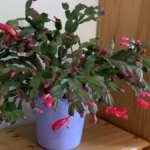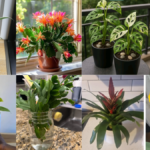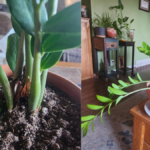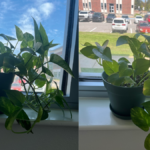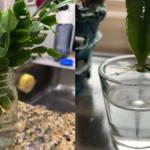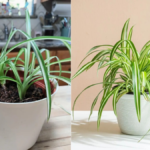How to Take Care of a Spider Plant – is very simple and beginner-friendly. This plant has long, green-and-white striped leaves that grow beautifully in pots, hanging baskets, and gardens. The best part is that spider plants not only look attractive but also clean the air naturally.
I have been growing spider plants for a few years, both inside my home and outside in my balcony garden. From my personal experience, I can say this plant does not demand too much care. Even if you forget to water it sometimes, it stays fresh. In this post, I am sharing all the easy care tips that I personally follow.
About Spider Plant
| Feature | Details |
|---|---|
| Botanical Name | Chlorophytum comosum |
| Common Name | Spider Plant, Ribbon Plant, Airplane Plant |
| Origin | Southern Africa |
| Type | Evergreen perennial |
| Uses | Home décor, air purifier, balcony plant |
Spider plants are very popular because they grow fast and produce baby plants, also called “spiderettes,” which hang down like tiny spiders.
Quick Tips for How to Take Care of a Spider Plant
- Use well-draining soil for healthy growth.
- Water only when the topsoil is dry.
- Keep in bright but indirect sunlight.
- Outdoors, place in partial shade.
- Maintain temperature between 15°C to 30°C.
- Fertilize lightly during the growing season.
- Repot every 1–2 years.
- Trim brown leaf tips with clean scissors.
Watering the Spider Plant
From my experience, spider plants grow best when you water them properly.
- Indoors: Water only when the top one or two inches of soil feels dry. Do not keep the soil soggy.
- Outdoors: In summer, I water my outdoor spider plants two to three times a week. In the rainy season, I water less because the soil already stays moist.
Tip: Tap water with too many chemicals can harm spider plants. I mostly use stored or filtered water, and I have noticed fewer brown tips on the leaves.
Best Soil for Spider Plant
Spider plants love light and airy soil.
- I usually prepare a mix of garden soil, coco peat, and perlite.
- For indoor plants, I add organic compost to improve the quality.
- Outdoor spider plants can grow in normal garden soil as long as it does not hold too much water.
Good drainage is most important, so always use pots with holes at the bottom.
Sunlight Needs
Spider plants can grow in different light conditions but they prefer indirect light.
- Indoors: I keep mine near a window where it gets bright light but not direct sunlight. Direct sun can burn the leaves.
- Outdoors: They do well in partial shade or filtered sunlight. Harsh afternoon sun should be avoided.
From my observation, spider plants kept in east-facing balconies look very healthy and green.
Humidity and Temperature
- Temperature range: 15°C – 30°C.
- Humidity: Spider plants like moderate humidity.
When the air becomes very dry, I lightly mist the leaves once or twice a week. I avoid placing them near heaters, air conditioners, or fans that dry out the air too much.
Fertilizing Spider Plant
I have noticed that spider plants grow fresh green leaves when they get some food during the growing season.
- Indoors: I use a liquid fertilizer once a month.
- Outdoors: I add compost or vermicompost to the soil every 2–3 months.
Do not over-fertilize. Too much fertilizer can damage the roots and cause leaf burn.
Propagation of Spider Plant
Spider plants multiply easily. I enjoy growing new plants from the babies.
Ways to propagate:
- Spiderettes (baby plants):
- Small baby plants hang from the mother plant.
- I cut them and place them in water or soil.
- Roots appear quickly and they grow into new plants.
- Division:
- When the plant becomes too big, I remove it from the pot.
- I gently separate the roots into smaller parts.
- Each part is planted in a new pot.
Both methods work well, but I mostly use spiderettes as it feels simple and fun.
Common Problems and Solutions
| Problem | Cause | Solution |
|---|---|---|
| Brown leaf tips | Chemicals in water, low humidity, extra fertilizer | Use filtered water, trim tips, reduce fertilizer |
| Yellow leaves | Overwatering | Let the soil dry before watering |
| Slow growth | Lack of nutrients | Add compost or fertilizer |
| Wilting | Too much sun | Shift to shade or indirect light |
Indoor vs Outdoor Care
- Indoor care: Needs indirect light, less frequent watering, and occasional misting. Looks good in living rooms and bedrooms.
- Outdoor care: Needs more water, grows well in hanging baskets, and should be protected from direct sun in summer.
I grow spider plants in both places. Indoors they bring freshness to the room, while outdoors they look very lively in hanging pots.
Conclusion
Caring for a spider plant indoors and outdoors is very easy. With proper watering, well-draining soil, and bright indirect light, the plant will stay healthy and keep producing baby spiderettes. From my own gardening journey, I can say this is one of the most rewarding plants to grow. It improves air quality, grows quickly, and adds greenery to any space. If you are looking for a low-maintenance houseplant, the spider plant is a perfect choice.
Common Spider Plant FAQ
How often should I water my spider plant?
Water your spider plant once a week, allowing the soil to dry slightly between waterings. Avoid overwatering to prevent root rot.
Does a spider plant need direct sunlight?
No, spider plants thrive in indirect sunlight. Too much direct sun can scorch the leaves, while low light may slow growth.
How do I make my spider plant bushy?
Keep your plant healthy by trimming brown tips, providing indirect light, and fertilizing monthly during the growing season.
Read More Post

